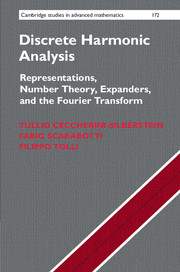Book contents
- Frontmatter
- Dedication
- Contents
- Preface
- Part I Finite Abelian groups and the DFT
- 1 Finite Abelian groups
- 2 The Fourier transform on finite Abelian groups
- 3 Dirichlet's theorem on primes in arithmetic progressions
- 4 Spectral analysis of the DFT and number theory
- 5 The Fast Fourier Transform
- Part II Finite fields and their characters
- Part III Graphs and expanders
- Part IV Harmonic analysis on finite linear groups
- Appendix Chebyshëv polynomials
- Bibliography
- Index
4 - Spectral analysis of the DFT and number theory
from Part I - Finite Abelian groups and the DFT
Published online by Cambridge University Press: 01 June 2018
- Frontmatter
- Dedication
- Contents
- Preface
- Part I Finite Abelian groups and the DFT
- 1 Finite Abelian groups
- 2 The Fourier transform on finite Abelian groups
- 3 Dirichlet's theorem on primes in arithmetic progressions
- 4 Spectral analysis of the DFT and number theory
- 5 The Fast Fourier Transform
- Part II Finite fields and their characters
- Part III Graphs and expanders
- Part IV Harmonic analysis on finite linear groups
- Appendix Chebyshëv polynomials
- Bibliography
- Index
Summary
2In this chapter, following [104] and the exposition in [15], we present the spectral analysis of the normalized Fourier transform on (cf. Exercise 2.4.13). In the last two sections, as an application, we recover some classical results in number theory due to Gauss and Schur, including the celebrated law of quadratic reciprocity.
Preliminary results
We will use the notation and convention as in the beginning of Section 2.2.
This way, the normalized Fourier transform is given by
for all and; see Definition 2.4.1.
Similarly, the corresponding inverse Fourier is given by
for all and. Note also that now Proposition 2.4.6.(iv) becomes
Recall (cf. Definition 2.4.14) that for we denote by the function defined by for all.
Proof. (i) and (ii) are just a reformulation of the Fourier inversion formula (Theorem 2.4.2) and the Plancherel formula (Theorem 2.4.3), respectively; they can also be immediately deduced from the orthogonality relations (Proposition 2.3.5).
Proposition 4.1.2
Proof. (i), (ii), and (iii) follow immediately from Lemma 4.1.1 after observing that for all, and.
Theorem 4.1.3 The characteristic polynomial of is given by
Proof. By virtue of Proposition 4.1.2.
Information
- Type
- Chapter
- Information
- Discrete Harmonic AnalysisRepresentations, Number Theory, Expanders, and the Fourier Transform, pp. 101 - 128Publisher: Cambridge University PressPrint publication year: 2018
